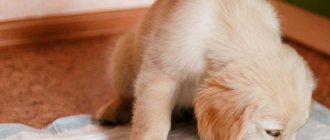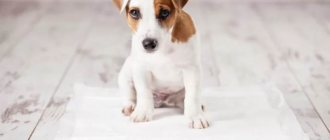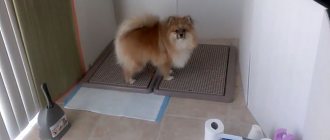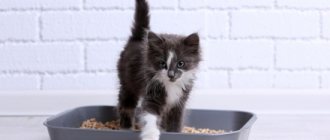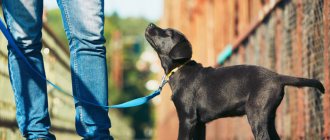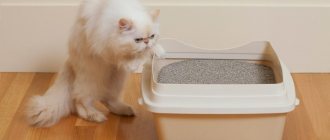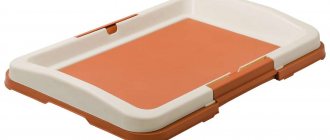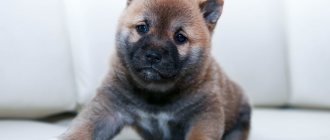Toilet for dogs in the apartment
There are three options for how to arrange a toilet for a puppy and an adult dog:
- regular newspaper;
- diaper - disposable or reusable;
- tray with special filler.
Each option has its own advantages and disadvantages. The litter box is more of a cat's version. Purrs like to bury waste, but dogs do not have such an instinct. They are more accustomed to doing their business for the newspaper. In turn, the newspaper may not please the owner: it smells more than the tray. Newspapers will have to be changed all the time, and diapers will have to be washed. It is better, of course, to accustom the dog to the tray, but if you fail to deal with the animal, you will have to get used to the diaper.
A soft diaper is an option more likely for a puppy or a small indoor dog. It is better to train a large dog in an apartment to use a litter tray.
Advice: when taking a puppy from a breeder, ask what the baby was accustomed to: a diaper or a newspaper. Keep it up so he gets the hang of it faster.
If preference is given to a tray, you need to choose an option without high sides and stable. A litter box that wobbles under the animal while it is there can keep the dog away from the litter box for a long time.
When the puppy gets used to the house a little and understands that he needs to do his business with it, it is better to also put the newspaper and diaper in a tray, a regular tray without any nets. If your pet doesn't like heights, replace it with a simple tray or car mat. This will make the toilet hygienic and prevent it from leaking onto the floor. Try not to change this pan, but keep it clean.
Important: the trays and the tray itself should not be washed with odorous cleaning products. Dogs are much more sensitive to odors than people - this can permanently scare your pet away from the toilet.
Having decided what the toilet will look like, choose the right place . To do this, you should watch your pet: even a small puppy will choose where to go, guided by its natural instincts. The dog will go to a place independently selected by the animal with great pleasure, and the training process will take less time.
Usually dogs like to arrange a toilet near doors, windows, and balconies. If the place suits you, make a toilet there. If not, it is best to install a litter tray in the bathroom, this way you will remove the unpleasant smell from the living rooms. It is important that the pet has free access there. Other non-residential places without carpets and unnecessary decor are also suitable: a corridor, a kitchen.
Wherever the place for the toilet is located, choose it once and for all, and then do not change it . Otherwise, the dog will get confused, trying to figure out where it can go and where it can’t.
Having chosen a place for the toilet, clear the surroundings: roll up carpets and paths. If the puppy marks the rug once, he will understand that peeing on something that is soft, fluffy and instantly absorbs moisture is much more comfortable. In the future it will be difficult to wean him off. In addition, removing odor from floor coverings is a non-trivial task.
During the first weeks of a puppy's life, the space around the toilet should be limited . He still doesn’t really understand where to go and why he needs to pee and poop on the diaper. Its territory should not exceed 1.5-2 square meters, with a bare floor, a bed and a diaper.
When the puppy wakes up, he looks for a place to go to the toilet. This is definitely not a couch, and between the floor and a soft cloth, the baby will choose the latter. You can gradually expand the territory, but without leaving an option for a toilet. More puppy - more territory - same diaper in the same place.
How to work with learning difficulties
- Place several diapers in those places where the dog most often misses. Gradually remove the less popular ones, those that the puppy uses less often.
- Pay attention to which diaper the dog wears most often. Perhaps he tells you the most comfortable place for him.
- If the puppy regularly misses and walks to the edge of the designated area or nearby, try buying a larger oilcloth or placing two nearby.
- If your baby tears up disposable bedding, plays with it, or drags it around the room, don’t swear. This is normal and natural for the baby. Offer him other toys, glue the bedding to the floor with masking tape for a while, so they will not rustle and provoke the dog.
- If the puppy refuses to poop in the diaper, watch the dog more closely, catch and take it to the designated place on time, and when it does, be sure to praise it.
We advise you to read: How many times to feed a puppy
How to teach?
To begin with, be patient. Remember: this is a living being, not a mechanism or a toy; mistakes are inevitable. It is impossible to toilet train a puppy instantly. Here's what to do:
- Observe the animal's behavior . Where does he like to write? In a dark corner or maybe by the window? This is where the toilet should be located.
- To begin with, one place for the toilet is not enough: the baby may simply not have time to get there. Place containers throughout the apartment and, as they grow, reduce their number to two.
- If you have little time to train your animal, limit its territory . Immediately after eating or sleeping - at this time dogs usually pee, put the baby in a fence. Let him sit there until he relieves himself, then you can let him out for a walk. If the dog is kept in a pen permanently, it should include toys, a bed, a toilet and some free, clean flooring.
- Try to bring your dog to the place where you put the diaper more often. Notice the moments when it is clear that the puppy wants to pee . The baby begins to spin around in one place, sometimes whining and sniffing. Immediately carry or lead your pet to the diaper tray.
- Refer to the breeder's experience . How did he train the puppy, what were his parents trained to do? It is better to choose an option that is already familiar to the animal.
- You can use special tools . They come in two types: repelling and attracting animals. First, for example, with Antipis, treat those surfaces where urination is undesirable.
- You can replace Antipis with a regular bowl of food . Puppies are tidy and will not urinate where they eat.
- That’s why the diaper needs to be changed often and the potty needs to be washed. Sometimes a clean puppy would rather be punished than urinate in a dirty place.
- If the baby did not calculate his strength and did not reach the toilet, you should not scold him . Just cover the floor with the diaper and let your puppy smell it. The area of the puddle must be washed thoroughly so that the dog does not think that the toilet is now here. By the way, detergents with chlorine are contraindicated: they only increase the smell of urine.
Important: if the puppy is very small, you can’t not only spank him, but even shout. Animals at this age are very sensitive. A stern note in his voice is enough for him. From 5 months onwards, you can use a slap on the butt - but in such a way that it does not hurt, but is offensive. In general, toilet failures are natural up to 8 months, so you shouldn’t scold too harshly.
Don’t forget about encouragement: every time the baby goes into a diaper, praise him. You can pet him, call him by name, speak in a gentle voice, and even give him a treat.
To understand how quickly a puppy will make a puddle again, use this calculation: a baby can tolerate approximately as many hours as he is months old.
First and basic rules: reward and punishment
The most important thing during training is the correct use of rewards and punishments. Before buying a pet, cover one of the rooms with absorbent diapers. After returning, sit the dog in the prepared place and wait for him to relieve himself. Praise your pet verbally and offer a healthy treat. Over time, treat the dog every other time, and then completely abandon such rewards. This will reinforce the desired habit not as a trick for a treat, but as an everyday action.
If the puppy does not go to the diaper, but does his business next to it, give him a stern reprimand. Don't yell or use physical punishment. This will not give results, but will only scare the animal. The pet should sense your displeasure, not your anger. Watch the fine line between these concepts.
If you notice a puddle or a pile after some time, calm down and treat the “crime scene” with a weakly concentrated vinegar solution or a special spray that destroys unpleasant odors. In this situation, punishment is meaningless. The animal will only understand that feces are “illegal”, which means they must be hidden from the owner. This often leads to coprophagia (eating excrement) or defecating behind sofas.
During training, consider:
- Favorite places. Follow the animal. At the time of urination and defecation, it is defenseless, so it often chooses dark corners away from prying eyes.
- Area of the training area. The smaller the area, the faster you can cope. Dog handlers advise limiting the territory of children to a small pen. Equip it with diapers and gradually reduce their number.
- The speed of movement of the dog bed. If you feel sorry for leaving your animal in the playpen, cover most of the apartment. This is no less effective, but takes more time. Move the absorbent mats daily within 10 cm towards the desired location, reducing their number along the way.
- Love for soft surfaces and cleanliness. Temporarily get rid of carpets and regularly change or wash used diapers.
Don't forget about consistency. Most babies defecate immediately after waking up and shortly after eating. Before this, they begin to whine, sniff the floor and circle in one place. If you notice this behavior, immediately take your pet to the right place. After a successful operation, praise your four-legged pet and feel free to let it out for a walk around the house.
Useful tips
To make the process of toilet training your dog easier, take the advice of experienced breeders. For example, if you do not want your dog to relieve itself in a certain place, use the special Antipis product, sold at any veterinary pharmacy. Spray the described area with the preparation and periodically renew the anti-odor.
To stop your pet from peeing in a certain corner, place a bowl of food there. The animal will not mess up where it eats.
If you are away for a long time, limit the free area for the puppy to move around. Ask the breeder what kind of toilet the puppies' mother and babies are accustomed to. At first, stick to the already familiar option for your baby.
Possible problems and their solutions
Despite the fact that in theory everything seems simple, in practice the owner may encounter a number of problems. But there are solutions for everything:
- The puppy goes to the diaper every two times.
Maybe he is still too young and simply does not have time to run, so he pees through his diaper. This is because they cannot stay for up to four months. This is the equivalent of trying to potty train a six month old baby. In older adults, the problem may be that the diaper is dirty, has an unusual smell, or is distracting.
- The puppy stopped wearing a diaper.
The reasons are the same as for periodic absenteeism. Don't get angry at the puppy and don't think he's doing it out of spite. With dogs, there is no such thing as “especially to get revenge.” For them, defecation and urination are completely normal physiological processes that do not cause disgust. Remember, a dog can happily eat his own or someone else's poop and not frown. It's disgusting in humans.
What you perceive as guilt is pinched ears, a closed posture, eyes on the ground, not an admission of guilt, but fear. Training can be stalled if you punish your puppy for not going to the diaper. What to do in such a situation? You need to exhale deeply, drink a cup of chamomile tea, collect your thoughts and understand that the puppy did not do it on purpose. Undo your actions and start learning from the beginning - put on a diaper, praise good luck and ignore mistakes.
If the puppy poops outside the diaper, an anti-gas treatment should be used. You should also remember that the dog will soon grow up, and by nature it is not expected that he will shit in his den, which has become your home for him.
- The puppy chews a diaper.
This is a very common problem for owners. Babies learn about the world through their mouths, they bite and chew on everything, especially when they change their teeth. First of all, provide the puppy with other items of his choice: balls, threads, tweeters. Don't forget to spend plenty of time playing with your baby and just talking.
Enough attention and toys, but the puppy still eats diapers. What to do in such a situation is not always clear. And you cannot do without a diaper, and there is a risk that the animal will swallow the bite, which can cause intestinal obstruction or vomiting. In this case, it is worth replacing disposable diapers with reusable ones and using a special rodent spray.
To the diaper
Depending on age
It is important to start the learning process as early as possible. All behavioral characteristics are formed in the animal up to 6-7 weeks. If by this moment the dog has not understood where to pee and why he will be scolded, it will get worse in the future.
1 month
You can’t do without mistakes at this age: the puppy still doesn’t really understand what’s happening to him and sits down wherever he wants. Imagine a human baby - how to teach him? Only gradually. Therefore, at first, watch where the puppy pees and put diapers in this place.
At first, the puppy will pee indiscriminately: both on the floor and on the diaper. But soon everything will change: the puppy will like a soft and moisture-absorbing place more than a bare floor. This way, a habit will gradually develop. And don’t forget to praise for every hit! In a couple of weeks, the baby will be wearing a diaper even at night, on purpose.
2
At the age of 2 months, the puppy will begin to urinate less frequently: only after feeding, sleeping and active play. Try to put him on a diaper immediately after these processes, see that the animal does its business. If it understands you and listens, praise it. You also need to take the puppy to the diaper when he starts to spin, whine and look for a place.
3
At 3 months old, a puppy is already growing up and must learn to find the toilet on its own. Stop wearing it, reduce the number of diapers to 1-2. There is no need to remove everything at once; it is better to remove one at a time every few days. If you make a mistake, you need to scold your pet a little in a stern voice.
Important Rules
- Teach your dog to listen to your intonations. Strict “Fu” should become law.
- If possible, buy diapers with filler that turns into gel. It will stay dry all day and prevent your puppy from getting his paws wet. He'll really like it.
- Place turf, dog droppings, or a rag used to wipe up urine on the diaper or in the tray - this will indicate that the need is being dealt with here.
- It is very important to reward your puppy for good behavior. This point is key in training. Every time your puppy behaves as expected, praise him. This is especially important in the first few months, when the baby is just learning how to behave correctly.
- If the puppy stubbornly refuses to wear a diaper, change the material, try newspaper.
Nuances
- Don't yell at the animal or hit it. This way you will only weaken the baby’s psyche and end up with an embittered, aggressive animal. If the puppy does not understand your strict intonations, it is not his fault . Try to work on your voice, achieve your goal calmly but steadily.
- You cannot poke your puppy's muzzle into an abandoned puddle. This is especially true for large, guard breeds: they are smart and will perceive this punishment as an insult. You will destroy trust from the very beginning.
- Don't over-praise. By 3 months, the puppy should already understand that going to the diaper is his responsibility, and you can’t beg for a treat every time. You don't want to feed your 5-year-old dog because he peed in the right place, do you?
You cannot scold the puppy if you discover a puddle after a while . The pet may misinterpret the output: it peed in the wrong place, the owner discovered it and scolded it. Therefore, it is necessary to hide the “traces of the crime” more carefully!
If you can maintain your temper, work patiently with the animal and not make these mistakes, complete victory awaits you.
Depending on the breed
Let's look at how to diaper-train puppies of several of the most popular breeds. The principle of training will not be different, but there are some features.
Chihuahua
At an early age, the Chihuahua has an accelerated metabolism; the dog will go to the toilet immediately after eating. Therefore, take the animal to the tray as soon as it has eaten. So that the baby understands that he needs to do his business in the tray, help him: pour a little water on the diaper lying inside, then put the puppy there. The baby will feel wet and urinate. Chihuahuas are very sensitive to the mood of their owners. So, if you show him your dissatisfaction, he will learn extremely quickly.
York
It is better to accustom a puppy of this breed to a diaper by fencing off the space. Do not think that it is inhumane to limit his movement area. It is inhumane to leave a baby in a huge, by his standards, unfamiliar space. The puppy can get hurt, eat something dangerous, and worst of all, they can step on him, because baby Yorkies are very restless and hover around their owner all the time.
Important: the diaper must be pressed down, otherwise the Yorkie will use it as a means of play..
Otherwise, this breed is very easy to train, especially in a play format. So you won't have any problems.
Spitz
If the baby was purchased from a nursery, then he is most likely already accustomed to the toilet-diaper. It’s just that, finding himself in a new place, he was a little confused. Your task is to help him remember the skill. With this breed it is also better to use the fence method.
Pomeranian Spitz puppies are very active, inquisitive, they climb everywhere (it is simply impossible to wean them off this). You will have to cover the entire floor in the enclosure with diapers so that babies urinate without interrupting their play, and only gradually reduce this space to one diaper.
Husky
It's not that simple. Until six months, a husky puppy is unable to control its own physiological processes. Until this age, their mother takes care of them. Well, if you tear the baby away from the mother too early, you will have to be patient. When you start toilet training your husky, you should use newspaper rather than a diaper. Otherwise, due to habit, the husky will mark the bed and carpets in the future.
Huskies are extremely clean, so change the newspaper often. And keep in mind that this is definitely not a breed that can be litter trained - they need to move a lot and be outside often
Labrador
This is a very smart dog, so you can immediately show what you want from it. As soon as the baby sits down to pee, say “NO” loudly, pick him up and carry him to the diaper. Hold there (but not too much) until he does his business. If everything worked out, vigorously express your approval. I broke free and ran away - no big deal, after a while everything will repeat itself and be remembered.
What are dog diapers and why are they needed?
Accustoming a puppy to a diaper helps reduce the number of walks, reduce their obligation and prevent the formation of a puddle in the wrong place. Diapers absorb moisture and unpleasant odors well. Some types are wash and dry, so they can be used several times.
What types of diapers are there?
Training a puppy is similar to diaper training a baby. Diapers consist of many absorbent layers. The bottom one is made of polyethylene, so there is reliable protection against leakage. Pet stores and veterinary pharmacies offer two options for hygiene products: disposable and reusable. The latter are more expensive, but pay for themselves in the duration of possible use.
Some products are scented. They leave a light, pleasant scent and effectively eliminate unpleasant odors. The size is selected individually, but usually the available options are only suitable for puppies and small dogs. Larger animals will be more comfortable in a spacious tray. If you teach them to urinate on a diaper from childhood, then as they grow older it is enough to transfer it to the tray. A familiar smell and instincts will prompt the right actions.
Thanks to the special material, the diapers do not slip on the floor. The risk of tearing the dense fabric when relieving yourself is minimal. Reusable models do not have to be washed by hand: they can withstand up to 300 machine washes on a delicate cycle.
How to use diapers for dogs and puppies
Accustoming to a new latrine is quick and takes no more than a month. Diapers are indispensable in the following situations:
- Frequent physiological urges
. One-month and two-month-old babies have poor control over urination and bowel movements. Waste products appear after active play, sleep and feeding. I have to clean every hour. This is very exhausting and not suitable for working owners.
- Lack of vaccinations against infections
. Up to 3.5 months, the pet is vulnerable to viruses and is unable to resist them when infected. The option of walking outside is not even considered until the vaccination quarantine ends.
- The need for night walks
. A strong desire to relieve oneself often appears in the middle of the night. Instead of walking your pet in the dark and losing few minutes of sleep before work, it is easier to train him to walk in a certain place right at home.
- Illness or old age
. After surgery or due to age, the pet cannot walk outside as usual. Diapers or diapers become a salvation.
A diaper toilet is a real salvation for people with a busy schedule. It allows you to avoid walking in severe frosts and heavy rains without harming your pet.
Features of training different breeds
The training technique is the same for everyone, but sometimes it is necessary to take into account some breed characteristics. The owners will have to master these nuances:
- Yorkshire Terriers. Yorkies are initially limited in their free space. Otherwise, training will be greatly delayed. Cover a small enclosure with diapers and equip it with everything you need.
- Husky. Puppies of this breed take a long time to learn on their own. They are raised by their mother until they are six months old. With earlier weaning, all worries are assigned to the owner. Breeders recommend accustoming them to newspaper, since otherwise any soft surface will be affected.
- Toy terriers and chihuahuas. The accelerated metabolism of these dogs results in frequent urination. They will have to be placed on the litter after each feeding. If you wet it a little with warm water, your pet’s urination reflex will work. Pets are good at capturing their owner’s mood, so they understand well what they want from them.
- Shpitsev. These curious dogs love to explore the world. You won't be able to keep them in the playpen, so stock up on reusable products that can cover most of your apartment.
- Labradors. Labradors are among the ten most intelligent dogs, quickly learn commands and understand their owner well. If you try to relieve yourself in the wrong place, say “No” or “Ugh”, pick up your pet and move it to the required place. If you succeed, don't forget about encouragement.
When purchasing a puppy, ask the breeder for your pet's personal diaper. Even a habituated animal gets lost in a new territory. A familiar smell will guide you in the right direction and prevent mistakes.
To the tray
Puppy
All puppies are accustomed to a diaper without any options, because up to 6 months they rarely walk outside with babies: they still do not perceive the big, noisy and scary world well, and most of them have not yet been vaccinated. But a tray is only needed for those animals that will rarely walk outside in the future.
Be prepared that the process of litter box training may not go quickly. Not every pet will agree to relieve itself in an apartment in a specially designated place. But there is less hassle with such animals. Popular litter box dog breeds are:
- Terriers.
- Chihuahua.
- Chinese Crested.
- Pekingese.
- Pomeranian and dwarf spitz.
The transition from diaper to tray is very important. Puppies are taught to go to the litter tray from 3-4 months. For babies, buy a tray with the lowest possible sides. If you have a girl, then you can keep this tray when the puppy grows up. And if the puppy is a boy, you need to immediately install the tray away from the wall so that it does not get damaged. As an option, lightly scold your baby every time he starts to lift his paw. Then the animal will get used to going to the tray like a girl.
The tray is placed in the place where the diaper used to be. At first, the described diapers are placed there - the puppy will understand by the smell that he needs to go there. After 2 days, the smell will already remain in the tray and you don’t have to put the newspaper in it.
Advice: choose a larger potty so that the baby can turn around in it and does not feel cramped.
Be sure to praise your puppy for his interest in the litter box. Let him walk around it and smell it. The first time he does his business there, reward him.
Now, if the puppy pees, you need to take it not to the diaper, but to the tray.
Important: when the baby makes a mistake, take him to the tray, but under no circumstances splash him in the tray or drag him there by the scruff of the neck! This will create a fear of the toilet in your animal.
Then it’s a matter of little things: watch the baby, scold him for misses and praise him for hits. The entire process of litter box training takes about a month.
Adult dog
They usually want to teach a dog that is no longer young to pee and poop in a litter tray in an apartment for three reasons:
- Animal disease. It cannot endure for long or go outside constantly.
- An untrained dog that constantly does not wait for a walk.
- Constantly busy owner, inability to walk the pet regularly.
When deciding to train an adult dog to go to the litter box, remember that it is not easy and will take a lot of time. If there are no compelling reasons for this, it is better not to torture yourself and the animal. If you decide that you need it, proceed as follows:
- Lock the dog in a separate room. She will be there for the near future. Carpets and anything soft need to be removed from it. Wait until the dog begins to defecate, take him by the collar and lead him to the tray. Show that things need to be done here.
- Treat the tray with a special scented product that will lure the dog. It is sold in veterinary pharmacies.
- Praise for every hit. For every mistake, scold, but without beating. It is best for the dog to be in sight at all times.
- Be sure to punish the animal if it defecates in the wrong place before your eyes. There can be no exceptions: otherwise the dog will understand that he may not be scolded, and will begin to test your strength. Do not forget that the animal may urinate from joy when the owner returns - in this case you should not scold him.
- When the dog gets used to it a little, you can release it from confinement, gradually expanding the space. But for now, watch the dog to see if he goes there.
Important: Depending on what breed of dog you have, it may take up to 30 days for you to be potty trained in the house.
How does the training process work?
The training process depends on the age of the animal. Adult dogs, trained in basic commands, understand a person much faster than stupid kids.
Puppy
The learning process begins a month after birth. If you do this later, you will have to spend more time. By 2 months, the dog has developed behavioral habits. If he is used to defecating all over the house, then it will be difficult to prove to him a different rule.
At first, it is difficult to distinguish a four-legged baby from a human child. He understands little of what is happening and sits down where the need strikes. Over time, the animal begins to understand the difference between a regular floor and a diaper toilet. In the first case, the paws get wet and begin to freeze, and in the second, they remain completely dry. The choice quickly shifts towards the latter option.
When you notice changes in your pet, do not forget to encourage him and praise him for his success. The owner's approval will strengthen the correctness of the choice made. The dog will begin to persistently search for the diaper even at night.
From 2 months, the frequency of trips to the toilet decreases. After eating, waking up and active games, sit the baby next to the diaper, but not on it. This reinforces independence. Don't forget about praise.
From 3 months, the number of trips is reduced to 2-3 times a day. Independence increases, so the number of bedding can be reduced. Leave only a few spare ones in those places where the dog made the most frequent mistakes.
Some breeders insist on starting training no earlier than 3 months. The only truth is that at this age the animal is easier to control by commands. There is nothing wrong with training your dog early. If you are not a breeder, then start training immediately after purchase, without regard to age.
The entire learning process can be described as follows:
- Preparing the site
. Avoid walk-through and noisy rooms. Remove all soft coverings from the floor that distract attention. The diapers can be immediately placed in the trays. This is suitable for decorative breeds that often relieve themselves at home. The absorbent bedding should be close to the bed so that the dog has time to run to it immediately after waking up.
- Recording time and symptoms
. The urge to go to the toilet appears not only after sleep, but also 10-15 minutes after a heavy lunch. Notice behavioral changes and respond to them promptly.
- Rewards and punishments
. Praise and treats are given only in case of success, and a stern tone is used when a mistake is detected.
- Timely cleaning
. If you are late with cleaning, your pet will prefer a cleaner place nearby, that is, it will pass by.
If all recommendations are followed, training can be reduced to 1-2 weeks. Such a quick result is typical for breeds with high intelligence and patient owners who do not scream.
Adult dog
The procedure for training an adult animal is similar. Absorbent bedding is used for representatives of decorative breeds, sick or too old dogs that are not able to go outside. Adult dogs are more intelligent and relieve themselves less often, making them easier to train.
Choose one of the rooms and place a diaper toilet in it. Attract your pet's attention and let him sniff the new device. Encourage interest in this place at the time of the first urge. If unsuccessful, blot the urine with bedding and let the dog sniff. Over time, he will understand what's what and will begin to go to the right place.
For faster adaptation, use hygienic mats that imitate a lawn. For male dogs there are special kits with a post.
Difficulties arise only if the dog was taken from the street at an adult age. You will have to spend a lot of effort and time, but do not despair - patient owners will definitely succeed.
Common mistakes
- Strictly punish the puppy, instill in him a fear of his owner. A frightened animal learns worse.
- Beat the animal for puddles and heaps discovered after a while. In particularly advanced cases, such behavior of the owner leads to coprophagia - eating one's own excrement. It is very difficult to wean a dog from this.
- Select the wrong size tray, without taking into account physiological needs, too tight. An adult male dog will need a tray with a post.
- Do not keep the tray clean.
- It is inconsistent to punish a dog by “closing your eyes” every other time.
- Ignore praise.
- Forget about constant training. Even an adult, accustomed individual sometimes presents a surprise. Plus, dogs can forget where their toilet is if you don't spend enough time with the animal.
Results
So now you know how to toilet train a puppy. Remember the most important thing:
- All puppies are initially diaper trained. This is done at the age of 1 to 3 months. Whether or not to accustom the baby to the tray is an individual decision for each owner.
- When accustoming a puppy to a diaper, you need to limit his space, reduce the choice to “a soft, comfortable diaper” and “an uncomfortable hard floor.”
- The best way to teach a puppy something is through praise.
- Hitting and yelling at a dog is the best way to scare and anger it, not to toilet train it.
- It is difficult to train an adult dog to use a litter box, but it is possible. It is important to choose the correct size and design of the tray.
- To toilet train a dog, consistency, strong nerves and patience are important.
If you listen to these tips, your pet will learn everything! And in the comments you can share your successes, exchange personal experiences, little tricks learned in practice, and brag about the successes of your pets. Capture your baby completing the first important thing in his life, share photos and funny stories! Make the process of toilet training as fun as possible for yourself, because a dog living in the house is, first of all, a lot of positive emotions and good impressions.
Tips and ways to study at 4 months
At the age of four months, an adult puppy begins to slowly control the process of urination and defecation. At this time, there is no longer any need to cover everything with diapers. One or two in a suitable place or tray is enough.
There is no need to scold the dog for mistakes just yet. Behavioral tactics should be as follows:
- went up to the diaper - actively praise, caress, maybe encourage her with a treat.
- After the bath, ignore it. There is no need to shout, express emotions violently, or punish. The dog will understand that he is being scolded, but the cause-and-effect relationship is not clear to him.
After four months, it's time for you to decide whether to walk your dog outside or not. If, for example, you are trying to train a Pomeranian puppy to use a diaper or litter box, there is no need to insist on defecation and urination outside the apartment. If we talk about larger breeds, then at this age you can not only take them for a walk in your arms, but also become completely familiar with the toilet on the street.
You might be interested
Raising and training a Labrador from the moment the puppy arrives in the house
As soon as the Labrador puppy is 7-8 weeks old, the new owner can safely take him home. …read more
Labrador puppy - care and education at home
When an incredibly funny and cute Labrador puppy appears in a family, not everyone is fully …read more
Maintenance, care and education of the Russian Toy Terrier - advice from dog handlers
The Russian Toy Terrier breed is very young: in our country the standard was formed in the 60s, and internationally ...read more
Raising and training Alabai (Central Asian Shepherd Dog) - advice from dog handlers
The Central Asian Shepherd is considered a “difficult” and rather specific breed. This is a freedom-loving herding dog, accustomed to ...read more
Jack Russell Terrier training - stages of raising a puppy
The Jack Russell Terrier is a very active dog. The breed belongs to the hunting family, so you need to be prepared for …read more
